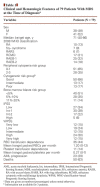Pathologic findings in novel influenza A (H1N1) virus ("Swine Flu") infection: contrasting clinical manifestations and lung pathology in two fatal cases
- PMID: 20154276
- PMCID: PMC7109771
- DOI: 10.1309/AJCPXY17SULQKSWK
Pathologic findings in novel influenza A (H1N1) virus ("Swine Flu") infection: contrasting clinical manifestations and lung pathology in two fatal cases
Abstract
Although novel influenza A (H1N1) virus infection has assumed pandemic proportions, there are few reports of the pathologic findings. Herein we describe the pathologic findings of novel influenza A (H1N1) infection based on findings in 2 autopsy cases. The first patient, a 36-year-old man, had flu-like symptoms; oseltamivir (Tamiflu) therapy was started 8 days after onset of symptoms, and he died on day 15 of his illness. At autopsy, the main finding was diffuse alveolar damage with extensive fresh intra-alveolar hemorrhage. The second patient, a 46-year-old woman with alcoholism, was found unresponsive in a basement and brought to the hospital intoxicated and confused. Her condition deteriorated rapidly, and she died 4 days after admission. The main autopsy finding was acute bronchopneumonia with gram-positive cocci, intermixed with diffuse alveolar damage. The pathologic findings in these contrasting cases of novel influenza A (H1N1) infection are similar to those previously described for seasonal influenza. The main pathologic abnormality in fatal cases is diffuse alveolar damage, but it may be overshadowed by an acute bacterial bronchopneumonia.
Figures




References
-
- Novel Swine-Origin Influenza A (H1N1) Virus Investigation Team. Dawood FS, Jain S, Finelli L, et al. Emergence of a novel swine-origin influenza A (H1N1) virus in humans. N Engl J Med. 2009;360:2605–2615. - PubMed
-
- World Health Organization Pandemic (H1N1): update 56. http://www.who.int/csr/don/2009_07_01a/en/index.html. Accessed July 2, 2009.
-
- Mauad T, Hajjar LA, Callegari GD, et al. Lung pathology in fatal novel human influenza A (H1N1) infection. Am J Respir Crit Care Med. 2010;181:72–79. - PubMed
-
- Soto-Abraham MV, Soriano-Rosas J, Díaz-Quiñónez A, et al. Pathological changes associated with the 2009 H1N1 virus. N Engl J Med. 2009;361:2001–2003. - PubMed
Publication types
MeSH terms
Substances
LinkOut - more resources
Full Text Sources
Medical

